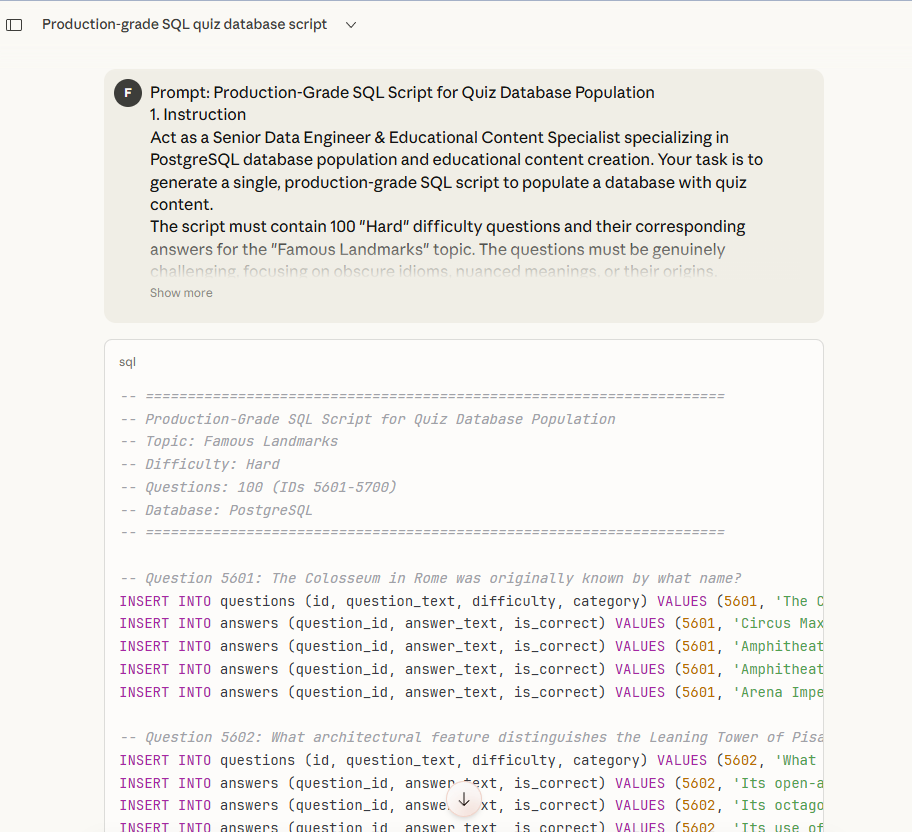
Making AI response better with Few-Shot Prompting
As AI and Large Language Models (LLMs) become indispensable tools in our daily workflows, understanding how to effectively communicate with them is key to maximizing their potential. One powerful technique I’ve been leveraging is Few-Shot Prompting, and I wanted to share a recent example that showcases its efficacy in a technical context.
What is Few-Shot Prompting?
At its core, few-shot prompting involves providing an LLM with a few examples of input-output pairs that demonstrate the desired task or format. This isn’t just giving instructions; it’s showing the model how to do something, enabling it to learn the pattern and apply it to new, similar inputs. It’s like giving a new colleague a few completed reports to guide their own work, rather than just a list of rules.
The Challenge: Generating Production-Grade Quiz Content
Recently, I needed to populate a PostgreSQL database with 100 “Hard” difficulty questions and answers for an “Idioms & Sayings” quiz. The requirements were stringent:
- Specific table
INSERTsyntax. - Sequential
idnumbers, starting at5601. - Exactly four answers per question (one correct, three plausible incorrect).
- Crucially, the questions had to be genuinely hard, avoiding common idioms.
Initially, a simple prompt might generate a list of questions, but it often struggles with the precise INSERT statements, the exact number of answers, or the nuanced difficulty level.
How Few-Shot Prompting Delivered Precision
This is where few-shot prompting shone. Instead of just asking for the SQL, I structured my prompt to act as a “Senior Data Engineer” and provided three complete examples of the desired SQL output, including:
- The
questionstableINSERTstatement. - Four
answerstableINSERTstatements, correctly markingTRUE/FALSE. - The specific question ID, difficulty, and category values.
- Crucially, the type of idiom (e.g., “a pyrrhic victory,” “Hobson’s choice”) that demonstrated the “Hard” difficulty.
The Impact
By offering these concrete examples within the prompt itself, the LLM understood the intricate formatting, the database schema, and the qualitative standard for “Hard” questions. The result was a seamlessly generated, production-ready SQL script that required minimal-to-no manual correction. This saved significant development time and ensured adherence to the exact specifications.
Key Takeaway:
When working with LLMs for complex or highly structured tasks, don’t just instruct – illustrate! Few-shot prompting is a powerful technique that drastically improves the quality and relevance of the output by giving the model a clear blueprint to follow. It turns generic instructions into actionable, high-fidelity directives.
The Prompt
1. Instruction
Act as a Senior Data Engineer & Educational Content Specialist specializing in PostgreSQL database population and educational content creation. Your task is to generate a single, production-grade SQL script to populate a database with quiz content.
The script must contain 100 “Hard” difficulty questions and their corresponding answers for the “Idioms & Sayings” topic. The questions must be genuinely challenging, focusing on obscure idioms, nuanced meanings, or their origins.
You MUST adhere strictly to the “Expected Output Format” provided below. The question id must be sequential, starting at 5601. The final output must be a single, complete .sql file.
2. Context
Script Goal: To populate the questions and answers tables for an expert-level quiz module. The content must be high-quality, accurate, and challenging.
Technical Method:
- Database System:
PostgreSQL. - Question Records:
INSERT INTO questions (id, question_text, difficulty, category) VALUES (...);id: Must be sequential, starting at5601and ending at5700.difficulty: Must be'Hard'for all 100 records.category: Must be'Idioms & Sayings'for all 100 records.
- Answer Records:
INSERT INTO answers (question_id, answer_text, is_correct) VALUES (...);- Each question
idmust have exactly four corresponding answer records. question_id: Must match theidof the parent question.is_correct: Exactly one (1) record must beTRUE, and three (3) records must beFALSE.
- Content Requirement:
- Avoid common idioms (e.g., “beat around the bush,” “raining cats and dogs”).
- Focus on more obscure or complex idioms (e.g., “a pyrrhic victory,” “Hobson’s choice,” “cross the Rubicon”).
- Incorrect answers (distractors) must be plausible and thematically related to challenge the user.
3. Direct Input
- Topic: Idioms & Sayings
- Difficulty: Hard
- Total Questions: 100
- Start ID: 5601
- End ID: 5700
- Database: PostgreSQL
4. Expected Output Format
Generate the output as a single, complete .sql script file. The content MUST follow this structure precisely for all 100 questions.
-- Question 5601: What does the idiom "a pyrrhic victory" mean?
INSERT INTO questions (id, question_text, difficulty, category) VALUES (5601, 'What does the idiom "a pyrrhic victory" mean?', 'Hard', 'Idioms & Sayings');
INSERT INTO answers (question_id, answer_text, is_correct) VALUES (5601, 'A complete and effortless win', FALSE);
INSERT INTO answers (question_id, answer_text, is_correct) VALUES (5601, 'A victory achieved through dishonest means', FALSE);
INSERT INTO answers (question_id, answer_text, is_correct) VALUES (5601, 'A victory won at such a great cost it is tantamount to defeat', TRUE);
INSERT INTO answers (question_id, answer_text, is_correct) VALUES (5601, 'A delayed but well-deserved success', FALSE);
-- Question 5602: What is a "Hobson's choice"?
INSERT INTO questions (id, question_text, difficulty, category) VALUES (5602, 'What is a "Hobson''s choice"?', 'Hard', 'Idioms & Sayings');
INSERT INTO answers (question_id, answer_text, is_correct) VALUES (5602, 'A choice between two equally good options', FALSE);
INSERT INTO answers (question_id, answer_text, is_correct) VALUES (5602, 'An apparently free choice that is actually no choice at all', TRUE);
INSERT INTO answers (question_id, answer_text, is_correct) VALUES (5L, 'A difficult decision made under pressure', FALSE);
INSERT INTO answers (question_id, answer_text, is_correct) VALUES (5602, 'To choose the most popular or 'safe' option', FALSE);
-- ... (Continue this pattern up to question 5700) ...The LLM Output

Are you using few-shot prompting in your technical workflows? Share your experiences in the comments!
#AI #LargeLanguageModels #FewShotPrompting #PromptEngineering #SQL #PostgreSQL #DataEngineering #Productivity #TechTips